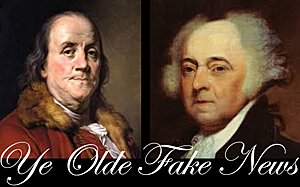


An Independence Day Salute to Our Founding Fathers of Fake News
By Thom Fladung/Hennes Communications
This 4th of July, amid the fireworks, hot dogs and parades, let’s remember another grand American tradition: making stuff up.
Or, as John Adams noted with delight in his diary in 1769, he’d spent the evening in “a curious employment. Cooking up Paragraphs, Articles, Occurrences etc. – working the political Engine!”
And Adams wasn’t unique among our nation’s great patriots.
In 1782, working on a homemade printing press in a Paris suburb, Benjamin Franklin created an entirely fake issue of a real Boston newspaper, the Independent Chronicle.
One of the fake stories reported that American forces on the New York frontier had discovered bags containing more than 700 scalps – bags of scalps from soldiers, boys, girls and even infants, all allegedly taken by Indians in league with King George. Franklin reported that a note from the Indians to King George, found with the bags, said they hoped he’d enjoy these presents and be “refreshed.”
But Franklin didn’t stop there. He composed a fake letter from a real naval hero, John Paul Jones, that repeated almost verbatim the Declaration of Independence including the portion at the end that says the colonies must declare independence.
For much more on fake news and its role in our country’s founding, see a wonderful piece by Robert G. Parkinson, an assistant professor at Binghamton University, in the Washington Post.
In today’s world of crisis communications, fake news in the form of false and misleading social media posts represent one of the most frequent and potent threats to an organization’s or person’s reputation. What do we tell Hennes Communications clients to do?
- Use social media before the crisis. Know where your customers and key stakeholders are on social media and engage them. Don’t wait until you’re under attack to “discover” Facebook and Twitter.
- Evaluate the threat. Where and how did it start? Who’s the source? How influential is the source? (But remember, influence can be earned online in seconds.)
- Don’t let mistakes or factual misstatements about you or your organization persist online.
- When it’s time to respond, do so as quickly as possible. An honest, factual, sincere response is more important than a perfectly polished response. Get in the game.
- Most of all, be transparent, tell the truth and back up your words with actions.
The big difference now, of course, between today’s purveyors of fake news and Benjamin Franklin (well, one of the big differences) is that it took Franklin’s fake newspaper weeks to reach America from Paris vs. today’s instantaneous distribution on Facebook or Twitter.
Nevertheless, Franklin effectively made his fake news go viral, at least as the term applies to 1782. He sent copies of his fake newspaper to colleagues. And guess what? The story about the Indians taking scalps as a gift to King George appeared in legitimate newspapers in New Jersey, Pennsylvania, Connecticut, New York and Rhode Island.
Can you imagine the response today if a politician got caught trying something like that? Never mind. We know you can imagine it. Happy Independence Day.
Thom Fladung worked at newspapers for 33 years and hated it whenever a newspaper ran a fake story as part of an April Fools’ Day prank. For more on how to effectively communicate amid a crisis or reputation-challenging event, contact Hennes Communications and ask about our social media training sessions.